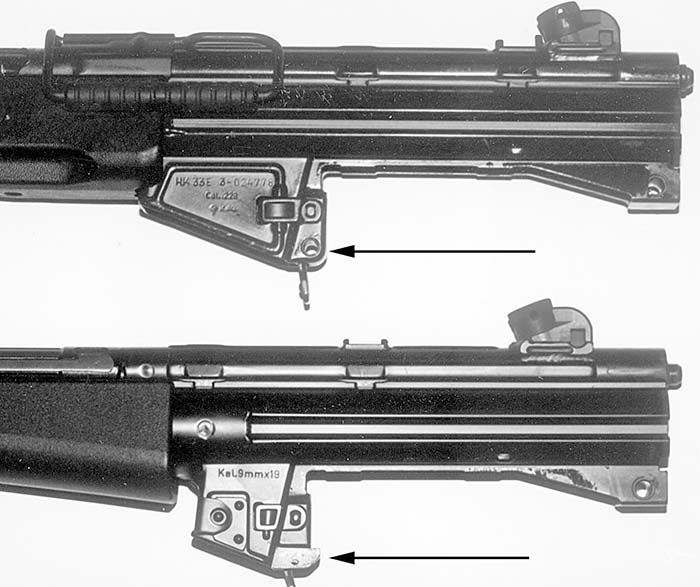Top: The original Push-Pin style machine gun receiver. Bottom: Semi-auto receiver with the clip-on attachment point.
By Thomas T. Hoel
Tom Hoel has done an outstanding job of his latest chosen assignment, classifying and technically describing the mechanical differences and roots of the various HK machine guns in the US Market. The work was so extensive that we are running it in a three part series. This is not a definitive work on “Who made what gun”, but a targeted technical work that should enable the prospective buyer to understand “How”, “Why” and perhaps more importantly; “What are the features that I want from the HK I am buying”. – Dan
Before 1986, it was a lucky Class II manufacturer who was able to procure enough original and authentic factory made machine gun parts to perform a complete receiver conversion back into the factory select fire specifications. Those authentic parts that were available, were always in short supply and priced accordingly. With current import law, price trends and world market forces, many do not remember that the cost of a conversion job to a semi-auto gun was considered prohibitive if it approached a few hundred dollars!! Thus, factory original parts were often viewed as a serious cost factor. Modifying the original semi-auto configured parts was often done as a matter of course, and economic reality. With H&K type guns it was always parts for the .308 caliber G3 rifles that were in greatest supply and so authentic parts, for say an MP5 SMG, were often nearly impossible to locate with any consistency or price control. This is one reason why there are such a disproportionately low number of registered receiver conversions that were done by a complete restoration to the factory select fire push-pin type, swing down trigger group, specifications.
The other major reason for registered receiver conversions being performed with unregistered conversion parts employed on a NFA registered unaltered semi-auto receiver was due to the simple fact that many of the active Class II manufacturers in the heyday of the conversion craze were less than Journeyman level skilled machinists or Gunsmiths. Compared to the recognized handful of true Artisans who today are active in the H&K repair/modification arena, there were some shops that turned out vast numbers of conversion guns with less-than-perfect machine work on them, and as a consequence many of these same shops quickly realized it was a lot easier to leave the expensive receiver alone and perform the needed mechanical alterations to the more easily worked on fire control packs and trigger housings. The required alterations to the semi-auto bolt carriers of guns from this general pedigree for instance, are often times of dubious quality and in need of rework to achieve reliable functioning.
It is fact that many Class II Manufacturers, and Form 1 approved individuals, decided to employ an altered semi-auto trigger pack for ease of conversion, while registering the receiver itself as the NFA controlled item. This of course left a dilemma as it allowed the existence of a semi-automatic configuration receiver which was registered as a legal machine gun, while producing an unregistered conversion part, which by law was allowed to exist as long as it always existed in physical contact with the NFA registered semi-automatic configuration receiver.
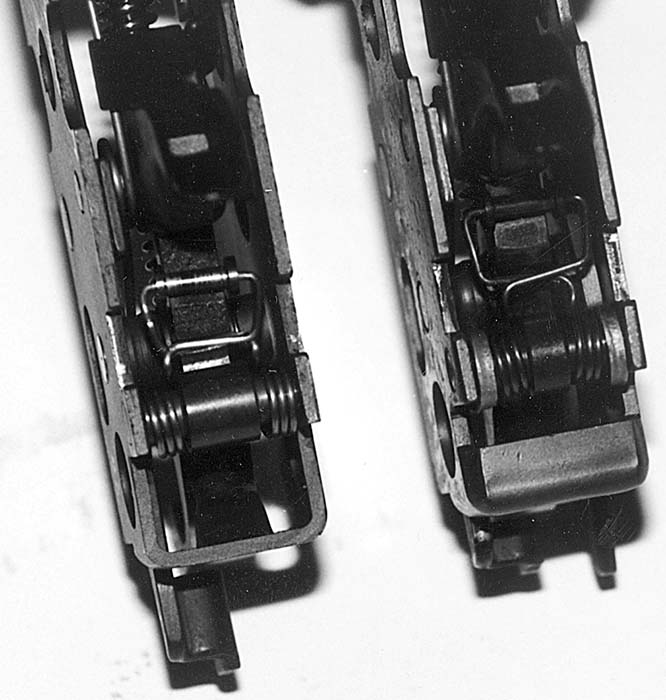
Into the murky depths…
ATF Technology Branch has quite emphatically ruled that a registered receiver gun, that as a registered conversion using a clip-on style trigger group housing, cannot be later converted to a different method of trigger housing attachment. In other words, a registered receiver conversion originally mechanically converted with a clip-on style trigger pack attachment method cannot later undergo a further alteration to a push-pin, swing down lower attachment provision. Plainly stated, ATF has ruled that the removal of the clip-on ledge piece of metal and subsequent drilling of the two pivot pin holes is, in and of itself, the act of manufacturing a NEW MACHINE GUN, regardless of whether or not the actual receiver is already registered as a machine gun!! While this may seem to make no logical sense at first glance, one must understand why ATF has taken this position and that is because they know that a registered receiver converted gun employing a ‘clip-on’ style trigger housing will have had to have been mechanically converted using a semi-auto fire control pack that has been modified to function in the selective fire mode, or in very rare cases a factory original machine gun pack and trigger frame altered to fit the clip-on attachment of the semi-auto receiver. They know that if you remove the clip-on ledge from the receiver, post initial conversion date, that you can then use a normal factory original machine gun-style fire control pack… all of which leaves the very interesting question of what happened to the original converted semi-auto fire control pack which had been modified to fire in the selective fire mode (or a modified machine gun pack and housing) and could, in and of itself, be used to convert another semi-auto gun!! Because the legal definition of what constitutes a ‘machine gun’ also defines conversion parts, or assemblies, to be ‘machine guns’ in and of themselves this leaves an “extra” unregistered machine gun out there. This is why the subsequent removal of the clip-on ledge, post initial conversion date, is creation of a NEW machine gun because presumably it frees up an unregistered conversion part (or assembly)! With a clip-on style trigger housing attachment method the actual NFA registered “machine gun”, as it was originally registered, is legally defined to be the combination of the semi-auto receiver and the original unregistered conversion part… not just the receiver alone!
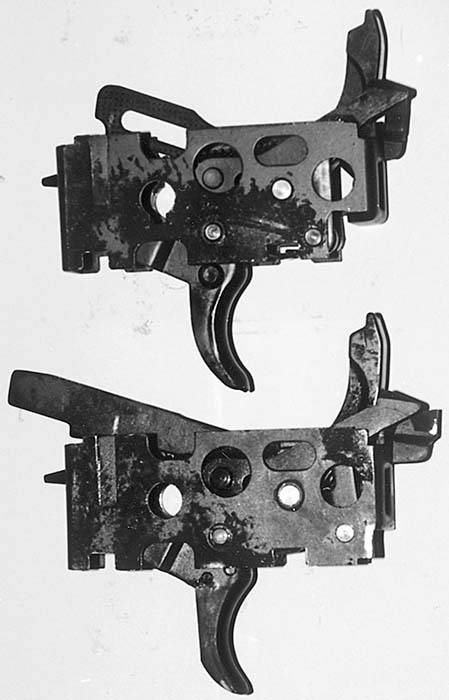
The genesis of this ATF philosophy is derived from the enactment of the Hughes machine gun freeze amendment which was slyly inserted into the otherwise good natured McClure-Volkmer Firearms Owners Protection Act, enacted on that now famous date May 19, 1986. The Hughes amendment forever capped the number of fully transferable machine guns available to civilians, and this fact is what drives the ATF position on further modification of already registered receivers. Even more interesting in this case was the position ATF Technology Branch took on the status of literally thousands of lawfully NFA registered machine gun conversion parts or kits, most of which were hastily registered shortly before the enactment date of the McClure-Volkmer Act. ATF Technology Branch had initially taken the official position that any lawfully registered machine gun conversion part or kit could be installed in the host firearm at a date later than the initial registration date. This meant that a manufacturer or lawful registrant could hold onto that registered conversion part or kit indefinitely until it was desired to affect the actual installation into a host firearm. Problems soon arose however when ATF Field Agents tasked with checking on the compliance of Class II manufacturers soon discovered that certain of these manufacturers, in a greedy rush to register as many fully transferable conversion items as possible prior to the cut-off date, had been less than forthright in their descriptions of the conversion parts or kits.
Many of these parts or kits fully failed ATF’s basic test for what constitutes a “machine gun conversion part” able to be lawfully NFA registered, in and of itself, as a machine gun. ATF Technology Branch has had to make the decision to allow the classification of certain items as “machine gun conversion parts or kits” based upon the technical possibility that installation of one of these parts of kits, without modification to the actual firearm receiver itself, could affect the alteration of the firearm into a fully automatic mode of fire. This was historically presented once before by the Technology Branch ruling in early 1969 on the NFA status of the so-called “M2 Carbine Conversion kit” after the enactment of the Gun Control Act. The key element in the allow ability of a “conversion part or kit” was that it had to be able to be installed without any additional modification to the receiver of the host firearm. Any amount of modification was allowed to any other component parts, but not to the actual Title I receiver or component parts defined as the Title I receiver. Unfortunately, many unscrupulous Class II’s, and some Form 1 approved individuals, had simply registered parts or “kits” that could in no way be physically installed without further modifications to the host firearms’ receiver. The now classic “registered AK auto sears” are the best example, although all manner of things were attempted including dead-stock M16 auto sears for “drop-in installation” into AR15 type receivers!! These “conversion parts or kits” were in no way physically possible of being installed without significant alterations to the host firearm receiver, and ATF soon had a major dilemma on its’ hands since literally thousands of these NFA registered conversion parts or kits now existed and they had to go about defining which ones were lawfully registered, and which ones were erroneously registered. There was also the significant question as to the status of those host guns which had previously had such parts or kits installed. Between May 1986 and December 1987 ATF had grudgingly allowed the installation of these NFA registered conversion parts or kits requiring additional receiver modifications, insisting that any host weapon so converted into a “machine gun” have the registered conversion part or kit “married” to the host receiver by serial number on the relevant registration form effectively forever preventing the future separation of host receiver (now modified) and the registered conversion part(s). This was to prevent subsequent removal of the registered conversion part, freeing up a modified Title I receiver which could accept new parts and continue to function as a machine gun. This concept of future separation is key to understanding the H&K conversion dilemma!!
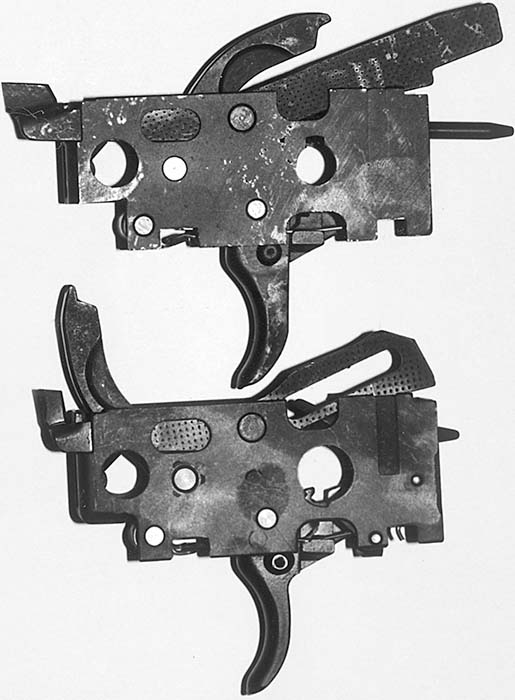
At the Las Vegas SHOT Show in January 1988, ATF declared in their Industry Seminar that those Title I semi-auto guns converted using a registered machine gun conversion kit, but which had required receiver modifications to be contraband and illegal! They further stated that those guns already converted using such methods would be considered individually, but that no further such usage of those type of NFA registered conversion parts or kits would be allowed. In effect, anyone holding a NFA registered machine gun conversion part or kit, that required receiver modifications to install it but had not already performed such an installation, were now in possession of contraband. This ruling was quickly applied universally to other conversions of semi-auto guns that had had their unmodified Title I receivers NFA registered as “machine guns”, but had been mechanically converted to automatic fire by the use of unregistered conversion parts, a practice here-to-fore having been declared marginally acceptable. The H&K conversion story all of a sudden got considerably less clear at this point. According to ATF, what now existed with H&K type NFA conversion guns were several disparate legally defined classes of registered conversions, though ostensibly all on the same type of gun!
So…just what ARE you looking at? The many possible scenarios.
First, you had those Registered Receiver conversions that had been originally mechanically converted to a legally defined machine gun receiver employing a factory MG style push-pin, swing-down style trigger housing. These guns occupy the pinnacle position of NFA conversions desirability status due to their unquestionable registration legality, duplication of factory mechanical features and cosmetic appearance, and ability to allow owner changes in factory style trigger groups along with enhanced spare parts availability.
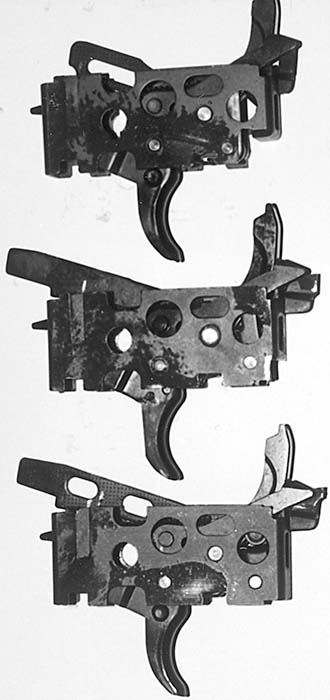
Next up, those “Registered Receiver” guns that had the unmodified Semi-auto Title I configured receiver NFA registered as the “machine gun”, but had been originally converted with an unregistered conversion part or device. These guns have several handicaps and vices. First, because of the above mentioned legal rulings their receivers could never be further altered to a push-pin, swing-down trigger group mounting style, which committed them to forever using the same trigger group and fire control pack as had originally been installed on the date of initial conversion and NFA registration, with one minor possible exception. Because of the usage of that unregistered conversion part in the modified semi-automatic fire control pack, that conversion part itself could never be replaced, only repaired! This is legally prevented because to replace it with a new one, if damaged or lost, would constitute new manufacture of an unregistered machine gun that was made illegal by the new 1986 Laws. Also, this prevented easy replacement of trigger group spare parts, as to convert the semi-automatic fire control pack to replicate selective fire, many of the fire control parts had to be heavily modified themselves. This was due to an altered mechanical geometry required by the need to have the same mechanical functioning as a factory selective fire pack, but in a geometry necessitated by the requirement of having the lower front edge of the fire control pack adapted to mount on the “clip-on ledge” of the semi-auto receiver. So, to get suitable replacement or spare fire control parts, one has to have standard parts that were specifically altered for usage in such a conversion, which are not typically available as easily as factory MG parts are now. The key is that with these types of “Registered Receiver” conversions, the NFA registered “machine gun” is the original combination of the unaltered clip-on style receiver, and the originally installed unregistered conversion part……those two entities can never legally separate, they are “married” for the life of the weapon!! All of these reasons are why this type of “Registered Receiver” conversion occupies the lowest level of desirability amongst registered receiver conversions, and are priced accordingly.
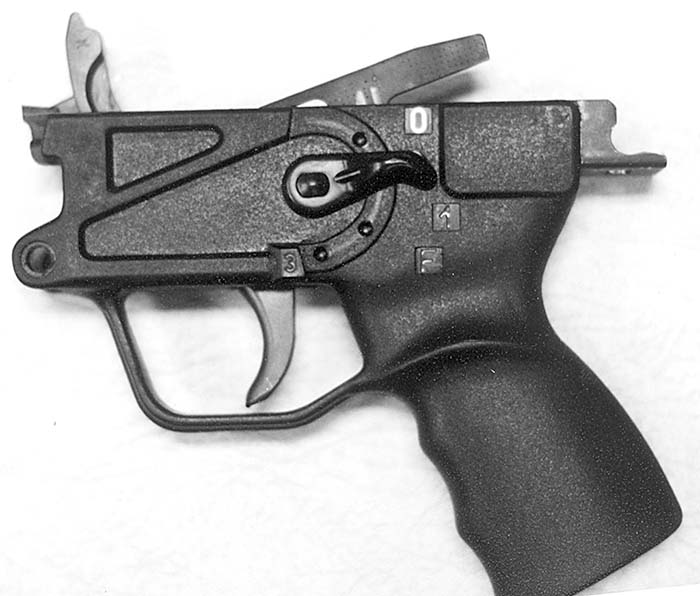
Even more disheartening in present times is the fact that since conversions of this type use an unregistered conversion part of most likely a proprietary design, unless you can re-install that exact conversion part in a different pack, you cannot replace the original style fire control pack with a perhaps more desirable version such a “Navy Group”, or 2-or-3-shot “Burst” style ambidextrous lower group!! (This problem also effects conversions using a “NFA Registered Sear” as will be seen)
[LEGAL WARNING! While it may be physically possible to adapt a factory select-fire ambidextrous style “Navy Group”, or “Burst” type trigger pack and plastic housing to fit a clip-on semi-auto receiver, it is patently ILLEGAL to simply adapt such a trigger group to fit, and then just clip it onto a “Registered Receiver” gun using a clip-on style housing attachment as you have just made a new, unregistered machine gun by doing so??…you’ve just created a complete conversion device to convert a semi-auto receiver!! The legal issue here, again, is that you are left with the original, unregistered conversion part being freed up when you swapped them out on your Registered Receiver conversion. There are currently available many of these adapted “Navy”/”burst”/Ambidextrous trigger groups offered for sale, but they are ALL illegal, unregistered conversion devices!! The ONLY way they are BATF legal is if they have been NFA registered as a Conversion device! This had to be either before the May 19, 1986 cut-off (which is HIGHLY unlikely due to very limited availability of these styles of factory parts then), or as a “post-86 Dealer Sample Conversion device”, or made at the request of Law Enforcement Agencies. ]
Lastly, somewhere in between the above two more common versions of registered receiver conversions are a very select group of Title I guns that were converted to select fire by a more questionable method…at least according to ATF Technology Branch after their early 1988 determinations and rulings. As alluded to previously, a select few semi-auto guns are known to have been converted by having their unmodified clip-on style receivers NFA registered as a “machine gun”, and then proceeding to attach a normal factory original MG select-fire, fire control pack and housing that had both been suitably modified together to clip-on attachment, as described above. These guns most likely were never visually inspected by ATF Technology Branch for suitability and conformance to approved methods prior to registration, and therefore “sneaked by” and into the NFRTR. In any era, these style conversions would be suspect as they contain an unmodified Title I receiver with its’ clip-on trigger group attachment point, and an unregistered drop-on conversion assembly. These guns are ripe for ATF making a determination that they were improperly registered, and may be subject to reclassification. Why the original registrant did not originally just register the converted trigger group assembly alone, instead of the receiver of the Title I gun, is a mystery… and a lingering problem for the current owner. These guns are just too much in a legal grey area to attach a reasonable sense of value to, and they are the perfect example of why a prospective purchaser of a “registered receiver” H&K conversion gun needs to extremely vigilant and aware of just exactly what particular gun he is looking at.
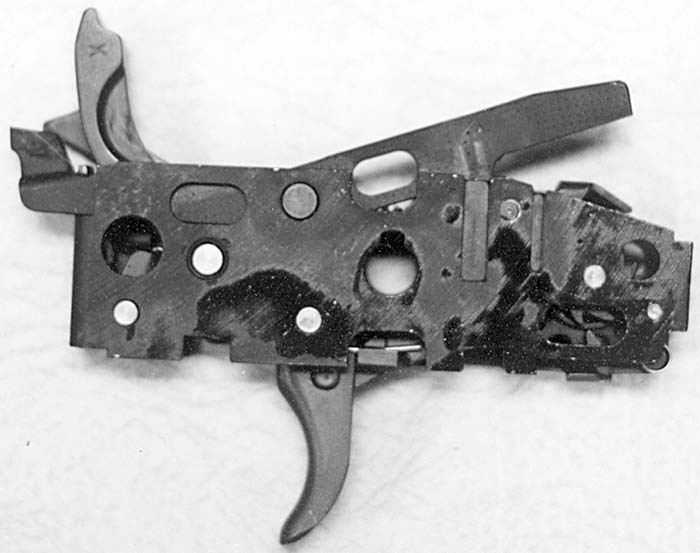
Within this understanding lies the major financial difference in perceived value of “registered receiver” conversion guns. A ‘fully converted’ gun able to use factory push-pin style, swing-down trigger groups is always deemed to be more inherently ‘valuable’ then a gun using a ‘clip-on’ trigger group, though the mechanical functioning is identical between the two guns. The perception is two-fold. First, on receivers able to use swing-down groups the ability to choose between the various factory offered styles of fire-control set-ups is greater, and they are simpler to exchange. Secondly, on registered receiver guns that employ a clip-on style group, at least one of the fire-control parts will be an unregistered conversion part, which means in practical terms that should this part break or be damaged it can only be repaired and never replaced, which limits to some small extent its’ serviceability. Thus, the ‘spare-parts question’ of a gun using a registered receiver employing a swing-down style trigger group is considerably better, hence an appreciable rise in value and pricing is accorded.
It is easy to see then that a ‘Registered Receiver Conversion’ is not so simply defined as just a receiver converted to be functionally identical to a factory original machine gun receiver with a push-pin style, swing down lower. It can exist in different forms, and those different forms determine a large difference in a monetary value, user friendliness, and perceived desirability.
The “Full” Registered Receiver Conversion… Top to Bottom
As previewed earlier the most desirable conversion method was to completely restore the Semi-auto Sporter receiver configuration back into a factory machine gun specification. This actually was done by several established Shops, and some individuals with the proper know how and skills, when they had the factory original select-fire trigger packs to install as part of the job. In order for this type of conversion to be unquestionably legal it had to have, at the time of initial conversion, the dedicated semi-auto receiver features completely removed, and then the two distinctive factory original machine gun receiver features restored. In proper order, this meant milling off the semi-auto receiver clip-on ledge, then align drilling the two pivot pin holes, and finally, welding in the pivot pin bushing, ALL THREE STEPS!
In actual practice, this was done with varying degrees of success, and/or completeness. One of the more well known Class 2 manufacturers had the habit of roughly milling off the clip-on ledge and drilling two holes, but not installing the pivot pin bushing which leads to oblongation of the pivot pin receiver holes after time. Many times the location for the pivot pin holes was roughly estimated by placing a factory style swing down lower on the receiver and using it as a template for drilling the pivot holes, which obviously led to a great deal of inaccuracy in their locations, all of which should be verified if a particular gun displays any untoward habits. Those conversions done by competent machinists using factory drawings and/or production data are unquestionably more desirable. Additionally, if a factory MG style “flapper” magazine release assembly was to be installed, the proper alignment of the pivot pin holes and the relative alignment of the pin bushing became critical, as this is what the flapper sleeve rides on, and bears against. An improperly aligned pivot bushing can prevent proper magazine release functioning.
Once the conversion of the trigger housing attachment was completed the only other significant detail to proper selective fire mechanical function was the bolt carrier. All HK type bolt carriers are manufactured the same, to machine gun specifications, until they are destined for a particular product line. For use in a semi-auto Sporter gun, the under surface of the carrier which contains a milled contour to activate the automatic sear trip lever in machine guns, is milled straight through, rendering it incapable of use in a machine gun. A restoration of this carefully contoured tripping surface is required. The bolt carrier is manufactured from high-tensile strength alloy steel that has been heat treated to resist wear, and on some versions additionally surface hardened in critical wear regions. This high quality material content and manufacturing method resulted in a piece that was extremely difficult to modify or alter with ease. To do it properly, the carrier should have been fully annealed, then had the milled areas filled in with a similar alloy content weld or plasma fill, finish contoured to factory surface spec and then final heat treated, and/or surface hardened, to restore the original wear and longevity properties. Almost no one ever did this as it is complex and time consuming, not to mention costly. Usually a weld fill and regrind sufficed, although a couple of shops adopted Stellite welding in an attempt to add wear resistance back into the tripping surface(s). The modified bolt carrier is one of the most commonly encountered areas of trouble from the original conversions, and fortunately now, a simple solution is at hand. With the current easy availability of original factory produced machine gun parts and parts sets, the best solution is to install a factory machine gun style bolt carrier, which has the proper sear trip surface intact.
With these modifications complete, the guns’ receiver has been fully restored into a virtual clone of the factory produced versions. As can be immediately seen, a gun so restored has the advantage of using the full range of “off the shelf” factory MG accessory trigger groups and spare parts. With the current ease of obtaining the more “modern” styles of plastic housing “Ambidextrous” trigger groups such as the so called “Navy Group”, or the various “Burst” style groups, a “Complete Conversion” is often valued an order of magnitude higher than the unmodified “Registered Receiver” conversions due simply to its’ unique ability to utilize all factory parts and accessories as originally intended without fitting or alterations. Essentially, these guns beat the MG Import Restrictions contained within the Gun Control Act of ’68, and at a considerably lower cost than a true “Original” which is undoubtedly now considered a collectors’ piece.
Tom continues with the HK “Sear” conversions in Part III of the series in the next issue of SAR.
| This article first appeared in Small Arms Review V3N8 (May 2000) |



